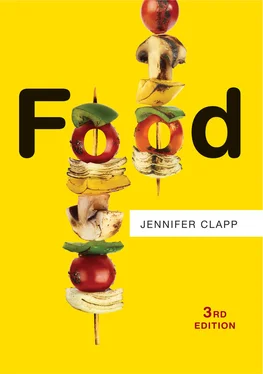CHAPTER ONE Unpacking the World Food Economy
Pause for a minute to reflect on how much you know about the path followed by the food you ate this morning as it made its way to your breakfast table. Of course, your understanding and knowledge depends very much on what exactly you had to eat. Some may know almost every detail of the production, transport, processing, and exchange relationships involved in the preparation of that meal – particularly those who choose to consume foods such as fresh eggs, oats, and strawberries from a local organic farm, or ethically traded shade-grown coffee from Nicaragua. Others may know very little, especially when they consume pre-packaged and highly processed foods like boxed cereal, frozen waffles, or instant hot chocolate. These latter items, most likely purchased from a neighborhood supermarket, made their way to your table after a long and winding journey through the global industrial food system. Most of us probably have a vague idea of our food’s origins and travels, as well as the power relationships that might be associated with it along the way, but we are not 100 percent sure.
The gap in our knowledge about the global food system can be understood as a kind of “distance” – which is often, but not always, related to the physical distance food travels from farm to table. Today, the average plate of food eaten in Europe and North America travels around 1,500 miles before it is consumed. The concept of “food miles,” picking up on the notion of physical distance, has attracted widespread attention in recent years, particularly because of growing concern about the greenhouse gas emissions associated with transporting food across great stretches of land and water. The distance between consumers and food can also be mental, as in the gap in knowledge we have about the social, ecological, and economic relationships associated with the foods we eat. And it can come in the form of power differentials between actors in the food system, where some experience its benefits while others absorb a disproportionate share of its costs. We often lack a full understanding of the natural and human conditions under which our food is produced and are only somewhat aware of who controls the various steps along the supply chains of the most basic and intimate resources necessary for human survival. 1In these various ways, we have become increasingly distanced from much of the food we consume.
Some say it’s not necessarily important for people to know all of the details of the functioning of the global food system – the web of relationships that span the production, processing, trade, and marketing of the food we eat. If that system conveniently provides safe, abundant supplies of food at affordable prices, then many consider that it is doing its job. Indeed, as the global reach of the industrial food system has expanded, with foods being traded across long distances, a greater variety of foods from around the world have become increasingly available to global consumers through the rapidly growing retail grocery market. This broader range of foods, such as fresh fruits and vegetables available year-round, can bring nutritional benefits to consumers. As scientific methods are employed to make foods last longer and better able to handle the journey to areas of the world that lack sufficient food supplies, wastage can be reduced. For the better part of the past fifty years, the system has outwardly appeared to provide the advantages of a truly global and stable food supply that could be accessed by an ever larger range of people. Its stability and abundance brought lower prices in addition to expanding its geographical reach. So long as the system is providing cheap and readily available food, why question it?
But questions have been raised about the benefits and costs associated with the way food is grown, processed, and marketed in the global industrial food system. Recent decades have seen heightened awareness of the ecological and social consequences of the current organization of that system. The increasingly obvious environmental side effects of large-scale industrial agricultural production, including biodiversity loss and exposure to toxins from the use of pesticides, have been of widespread concern since at least the 1970s. The commercial planting of genetically modified (GM) crops since the 1990s has raised questions about their potential ecological consequences. The reality of a warming climate, as demonstrated by extreme weather patterns in recent years, has added uncertainty to the productive capacity of the agricultural sector and has drawn attention to the fact that around one quarter of global greenhouse gas emissions is associated with the food and agriculture sector. As temperatures rise, analysts have stepped up warnings about potential food shortages in the not too distant future. These concerns have prompted calls for change, not just in production methods, but also toward more sustainable diets that move away from consumption of animal protein, such as eggs, dairy, and meat, which place a much higher ecological toll on the planet than plant-based foods. Meanwhile, approximately one third of the world’s food production is lost or wasted.
Uncertainty about the impact of environmental change on food is layered on top of what is seen by many to be unfair conditions for farmers in both rich and poor countries, as corporate actors have become more and more powerful in determining the circumstances of their livelihoods. There are 2.5 billion people – including 350 million indigenous peoples – engaged in small-scale agriculture and food production, who collectively manage approximately 500 million small farms. Estimates vary on the proportion of the world’s food supply that these small-scale farmers produce, ranging from 30–35 percent on the lower end, and up to 70–80 percent on the higher end. While it is difficult to know their precise production levels due to data limitations, there is growing understanding that small-scale and family farming is a major contribution to global food production, especially in sub-Saharan Africa and Asia. At the same time, these small-scale producers have access to only around 30 percent of the resources devoted to the sector. Many of these farmers practice sustainable forms of agricultural production, but their livelihoods are under threat.
At the same time, a “triple burden” of malnutrition has emerged that threatens human wellbeing. These are: (1) chronic undernutrition (inadequate intake of sufficient calories, affecting over 820 million people); (2) overnutrition (excessive intake of calories, affecting over two billion people in the form of overweight and obesity); and (3) micronutrient deficiencies (inadequate intake of vitamins and minerals, affecting over 1.5 billion people). One or more of these categories of malnutrition affect a significant proportion of the world’s population, in rich and poor countries alike. 2
Worries about these issues have spurred a small but growing movement that seeks to promote alternative food systems that maximize the ecological, social, and health benefits of food, rather than profits. These movements highlight the fact that there are, in fact, many food systems that operate at local and national levels, many of which have different priorities. These food systems, however, are still dwarfed by the size of the global industrial food system, which affects both producers and consumers in myriad ways, even if they participate almost exclusively in alternative food systems.
Further impetus for questioning the current global food system came with the sharp increase in food prices on global markets in 2007–2008 and again in 2011–2013. These price spikes served as a stark reminder of the gap in our knowledge about the forces that control outcomes in the global food system. When food prices began to rise quickly and dramatically, there was a great deal of uncertainty, even among experts, as to what exactly caused these major disruptions in global food markets. Some cited a misalignment of supply and demand fundamentals as the principal culprit. But others dismissed those explanations and pointed to other factors, including macroeconomic conditions, biofuel policies, trade practices, and financial speculation on commodity markets.
Читать дальше












